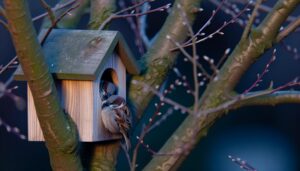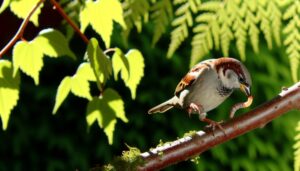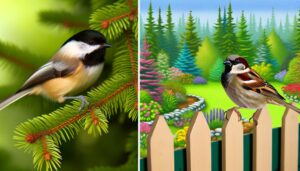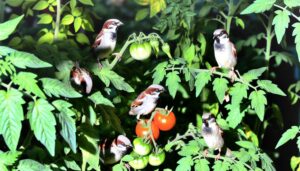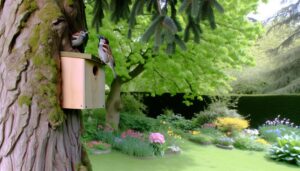10 Key Differences: House Sparrow Vs Purple Finch
The House Sparrow (Passer domesticus) displays a grayish-brown plumage and thrives in urban areas, nesting in man-made structures and exhibiting dietary plasticity. In contrast, the Purple Finch (Haemorhous purpureus) features striking raspberry-red males, inhabits mixed woodlands, and has a specialized diet favoring coniferous seeds.
House Sparrows emit simple chirps and exhibit complex social structures, while Purple Finches are known for their melodious warbles and strong pair bonds. House Sparrows adapt well to urban environments, whereas Purple Finches prefer forested areas.
The differential ecological preferences and behaviors underscore their unique adaptations and survival strategies. Further observations reveal deeper insights.

Key Takeaways
- House Sparrows have muted grayish-brown tones, while male Purple Finches display striking raspberry-red plumage.
- House Sparrows thrive in urban environments, whereas Purple Finches prefer mixed woodlands and coniferous forests.
- House Sparrows are opportunistic foragers, consuming grains and human food scraps, while Purple Finches specialize in seeds from coniferous trees and shrubs.
- House Sparrows emit monotonous chirps for social interactions, whereas Purple Finches are known for their melodious and intricate warbles.
- House Sparrows nest in man-made structures, while Purple Finches nest in natural cavities within coniferous forests.
Physical Appearance
The physical appearance of the House Sparrow (Passer domesticus) and the Purple Finch (Haemorhous purpureus) reveals significant differences in plumage, body size, and distinctive markings, which are essential for accurate identification in the field.
The House Sparrow typically exhibits a more muted coloration with grayish-brown tones, a distinct black bib, and white cheeks in males. Females display more subdued brown and streaked patterns.
In contrast, the Purple Finch male showcases a striking raspberry-red plumage, especially on the head, chest, and back. Females and juveniles are brown with heavy streaking.
The House Sparrow averages 14-18 cm in length, while the Purple Finch ranges slightly larger at 15-16 cm, allowing for differentiation based on size and color.
Habitat Preferences
House Sparrows mainly inhabit urban and suburban environments, often nesting in buildings and other man-made structures. Their adaptability to human-altered landscapes allows them to thrive in densely populated areas. They exhibit a preference for environments with abundant nesting sites and food sources, typically avoiding dense forests and remote areas.
In contrast, Purple Finches prefer mixed woodlands, open coniferous forests, and forest edges. They are frequently found in areas with ample tree cover, which provides suitable nesting sites and protection from predators. During migration, Purple Finches may also be spotted in more diverse habitats, including shrublands and gardens. Their habitat selection is closely tied to the availability of seeds and berries, essential for their survival and reproductive success.
Feeding Habits
Exhibiting diverse dietary preferences, House Sparrows mainly consume grains, seeds, and human-provided food scraps, while Purple Finches show a strong preference for seeds, particularly favoring those from coniferous trees and various shrubs.
House Sparrows demonstrate opportunistic foraging behavior, frequently scavenging in urban environments, which has facilitated their adaptability and survival across diverse habitats. Their diet includes millet, cracked corn, and breadcrumbs, reflecting a high level of dietary plasticity.
Conversely, Purple Finches are more specialized, with a diet mainly comprising sunflower seeds, buds, and berries from specific plant species. This specialization necessitates access to forested areas rich in coniferous vegetation, aligning with their ecological niche.
Both species exhibit seed-cracking adaptations, with robust beaks suited for their respective dietary requirements.
Vocalizations
Characterizing their vocal behaviors, both House Sparrows and Purple Finches produce distinct and complex sounds that play important roles in communication, territory defense, and mating rituals.
House Sparrows (Passer domesticus) emit a series of chirps and cheeps, often described as monotonous yet variable in pitch, used mainly for social interactions and alerting conspecifics to potential threats.
In contrast, Purple Finches (Haemorhous purpureus) are known for their melodious warbles, which are intricate and varied, incorporating a mix of short notes and trills. These vocalizations are essential for attracting mates and establishing dominance within their habitats.
Both species exhibit remarkable vocal flexibility, allowing them to adapt their sounds to environmental contexts and social dynamics, thereby enhancing their survival and reproductive success.
Breeding Behaviors
Breeding behaviors in both House Sparrows and Purple Finches exhibit distinct nesting strategies, mate selection processes, and parental investment patterns that are vital for the propagation of each species. House Sparrows typically build their nests in man-made structures, displaying a preference for urban environments. They engage in monogamous pair bonds but may seek extra-pair copulations. Purple Finches, on the other hand, favor coniferous forests for nesting and demonstrate a strong pair-bond with significant male involvement in feeding the female during incubation.
| Aspect | House Sparrow | Purple Finch |
|---|---|---|
| Nesting Sites | Man-made structures, urban areas | Coniferous forests, natural cavities |
| Mate Selection | Monogamous, extra-pair copulations | Monogamous, strong pair-bond |
| Parental Investment | Male and female share feeding duties | Male feeds female during incubation |
These breeding behaviors are essential for understanding their ecological adaptations.
Seasonal Migrations
The House Sparrow (Passer domesticus) shows minimal migratory behavior, usually staying within a localized geographical range year-round, while the Purple Finch (Haemorhous purpureus) partakes in extensive seasonal migrations.
The timing of migration for the Purple Finch is influenced by photoperiod and food availability, resulting in distinct north-south movements along established flyways. These migrations correspond to significant habitat shifts, with the Purple Finch inhabiting boreal forests during the breeding season and shifting to mixed woodlands or urban areas in winter.
Migration Timing Differences
Distinct migratory patterns are observed between House Sparrows (Passer domesticus) and Purple Finches (Haemorhous purpureus), influenced by their respective ecological adaptations and geographical ranges.
House Sparrows, being largely sedentary, show minimal seasonal migration, with local movements often driven by food availability rather than climatic changes.
In contrast, Purple Finches exhibit more pronounced migratory behavior. Typically, they migrate from their breeding grounds in the boreal forests of Canada and the northeastern United States to wintering habitats in the southern United States.
The timing of these migrations is influenced by photoperiodic cues and temperature fluctuations, generally occurring from late September to early October for southward movement and from March to April for the return northward. This temporal migration strategy aids in resource optimization and survival.
Preferred Migration Routes
Given the differences in migration timing between House Sparrows and Purple Finches, their preferred migration routes also reflect distinct ecological strategies and habitat requirements. House Sparrows, primarily non-migratory, exhibit localized movements influenced by urban and suburban environments.
In contrast, Purple Finches undertake more extensive seasonal migrations, often traveling between boreal forests and temperate zones. These routes are determined by:
- Geographic Range: House Sparrows have a widespread presence, reducing the necessity for long migrations.
- Resource Availability: Purple Finches migrate to exploit seasonal food resources, primarily seeds and berries.
- Climatic Adaptation: Purple Finches are adapted to withstand colder climates during breeding, necessitating migration to milder regions during winter.
This divergence underscores the species-specific adaptations in their migration behaviors.
Seasonal Habitat Changes
How do seasonal habitat changes impact the migration patterns of House Sparrows and Purple Finches, given their differing ecological needs and adaptations?
House Sparrows (Passer domesticus), being largely non-migratory, exhibit minimal seasonal habitat changes, primarily adjusting their foraging locations within urban and suburban environments.
Purple Finches (Haemorhous purpureus), however, are partial migrants, with movements influenced by food availability and climatic conditions. During winter, Purple Finches migrate southward from boreal forests to temperate regions, seeking coniferous and mixed woodlands rich in seeds.
This seasonal migration is dictated by resource scarcity in northern habitats. In contrast, House Sparrows' adaptability to human-altered landscapes reduces their need for extensive migration, underscoring significant ecological and behavioral divergences between the two species.
Social Structures
In examining the social structures of House Sparrows and Purple Finches, notable differences are observed in their group dynamics and mate selection behaviors.
House Sparrows exhibit a highly gregarious nature, often forming large, cohesive flocks, whereas Purple Finches demonstrate a more loosely associated flock structure.
Additionally, mate selection in House Sparrows involves complex social hierarchies and frequent aggressive interactions, contrasting with the more straightforward pair-bonding observed in Purple Finches.
Group Dynamics
Group dynamics in House Sparrows (Passer domesticus) are characterized by their highly social behavior and tendency to form large flocks, while Purple Finches (Haemorhous purpureus) exhibit more solitary and territorial interactions, particularly during the breeding season.
House Sparrows benefit from flocking in several ways:
- Foraging Efficiency: Larger groups can locate food sources more quickly and efficiently.
- Predator Detection: Increased vigilance within a flock leads to early predator detection and enhanced survival.
- Social Learning: Information transfer among individuals facilitates adaptation to environmental changes.
In contrast, Purple Finches prioritize solitary behavior outside communal feeding areas, relying on strong territorial instincts to secure breeding sites and resources. This divergence in social structures underscores distinct adaptive strategies driven by ecological pressures.
Mate Selection
Mate selection in House Sparrows and Purple Finches is profoundly influenced by their respective social structures and ecological niches.
House Sparrows (Passer domesticus) exhibit a polygynous mating system, where males defend territories to attract multiple females. Female mate choice is driven by male territory quality and resource availability.
In contrast, Purple Finches (Haemorhous purpureus) display monogamous pair bonds, with males engaging in elaborate courtship displays, including singing and feeding the female. Female Purple Finches assess male fitness based on plumage coloration and song complexity, indicators of genetic health.
These differing strategies reflect adaptations to their environmental pressures and social hierarchies, optimizing reproductive success within their distinct habitats. Understanding these mechanisms provides insight into avian evolutionary biology and behavioral ecology.
Adaptability to Urban Areas
Both the House Sparrow (Passer domesticus) and the Purple Finch (Haemorhous purpureus) exhibit varying degrees of adaptability to urban environments, influenced by their distinct behavioral and ecological traits.
The House Sparrow's prolific urban presence can be attributed to:
- Dietary Flexibility: Capable of exploiting a wide range of food sources, including human-provided resources.
- Habitat Utilization: Proficient at nesting in man-made structures, enhancing reproductive success.
- Social Behavior: Strong flocking tendencies improve survival in densely populated areas.
Conversely, the Purple Finch demonstrates lower urban adaptability. This species prefers natural habitats and exhibits less plasticity in diet and nesting sites.
Consequently, Purple Finches are less commonly observed in urban settings, favoring suburban and rural locales where native flora is more abundant.
Predators and Threats
Both the House Sparrow (Passer domesticus) and the Purple Finch (Haemorhous purpureus) encounter a variety of predators, including raptors such as hawks and owls, as well as domestic cats.
Additionally, habitat destruction and environmental pollution pose significant threats to their populations.
These factors collectively impact their survival rates and necessitate conservation strategies to mitigate adverse effects.
Common Predators Identified
House Sparrows (Passer domesticus) and Purple Finches (Haemorhous purpureus) face predation threats primarily from avian raptors such as hawks and owls, which exploit their diurnal and nocturnal activities respectively.
These small passerines are also targeted by various mammalian predators and reptiles.
Key predators include:
- Hawks (Accipitridae): Broad-winged hawks and Cooper's hawks are adept at hunting these birds during daylight.
- Owls (Strigiformes): Species such as the Eastern Screech-Owl and Great Horned Owl pose noteworthy nocturnal threats.
- Domestic Cats (Felis catus): Highly opportunistic hunters, domestic cats notably impact urban and suburban bird populations.
Understanding these predation dynamics is essential for developing effective conservation strategies and mitigating population declines.
Environmental Threats Faced
In addition to predation, House Sparrows and Purple Finches are increasingly threatened by habitat loss, pollution, and climate change, which collectively worsen their vulnerability to environmental stressors.
Urbanization and agricultural expansion result in significant habitat fragmentation, reducing nesting sites and food resources.
Pollution, particularly from pesticides and industrial contaminants, disrupts their reproductive success and causes physiological harm.
Moreover, climate change induces phenological mismatches, impacting migration patterns and food availability.
These species also face competition from invasive avian species, which further reduces their ecological niches.
Integrative conservation strategies, incorporating habitat restoration, pollution mitigation, and climate adaptation measures, are crucial to mitigate these threats and ensure the long-term viability of House Sparrows and Purple Finches.
Conservation Status
The conservation status of the House Sparrow (Passer domesticus) and the Purple Finch (Haemorhous purpureus) highlights contrasting population trends and ecological pressures.
The House Sparrow is classified as 'Least Concern' by the IUCN, yet its numbers are declining in urban areas due to habitat loss and pollution. Conversely, the Purple Finch is also listed as 'Least Concern,' but faces different challenges, including competition with the House Finch and habitat fragmentation.
To further understand their status:
- Population Trends:
House Sparrows show significant urban decline, while Purple Finches have stable but localized populations.
- Ecological Pressures:
Urbanization affects House Sparrows more, whereas Purple Finches face interspecies competition.
- Conservation Actions:
Both species benefit from habitat preservation and pollution control measures.
Tips for Birdwatchers
Birdwatchers seeking to distinguish between the House Sparrow and the Purple Finch should focus on key morphological differences, such as plumage coloration and beak shape.
The House Sparrow exhibits a more uniform, brownish-gray plumage with a noticeable black bib in males.
In contrast, the Purple Finch showcases a vivid raspberry-red hue in males, especially on the head, throat, and chest. Female Purple Finches display streaked brown patterns, differing from the more homogenous coloration of female House Sparrows.
Additionally, the beak of the Purple Finch is conical and robust, optimized for seed consumption, whereas the House Sparrow's beak is shorter and more pointed.
Observing these distinct characteristics in natural habitats can enhance accurate identification for even novice ornithologists.
Conclusion
The comparative analysis of the house sparrow (Passer domesticus) and the purple finch (Haemorhous purpureus) reveals distinct differences in physical appearance, habitat preferences, feeding habits, vocalizations, breeding behaviors, and adaptability to urban environments.
Surprisingly, house sparrows have shown remarkable adaptability, with urban populations increasing by approximately 20% over the last decade. Both species face various predators and threats, yet their conservation statuses remain stable.
Observations such as these are invaluable for birdwatchers seeking to distinguish between these avian species.

